BARGAINING
Bargaining is the name of the game in any market, street stall, or craft shop. You're expected to bargain
-- it's part of the fun of going to Africa. Start off at 50% lower than their initial asking price. You'll
end up some where in between, and you'll both be happy.
Angela had suggested bringing old t-shirts or shoes to barter with. Jeff and I decided to play good guy,
bad guy; with him saying
no and I keep asking for a lower price. We didn't like bargaining in the beginning, but we got pretty good
at it by the end of the trip!
THINGS WE BOUGHT
**Click any photo to view a larger image**

![]()
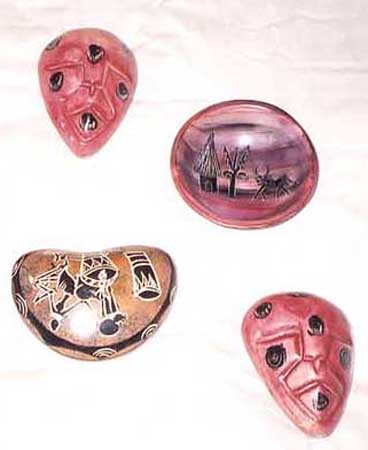
Soapstone
Egg and egg cup holders; vase; (8) napkin rings; dish; decorative containers.
Soapstone is a soft metamorphic rock mined for centuries in Kisii, Kenya. Out of this rock the expert Kisii
carver will chisel out an unique carving, and it can be hand dyed, incised, or left natural.
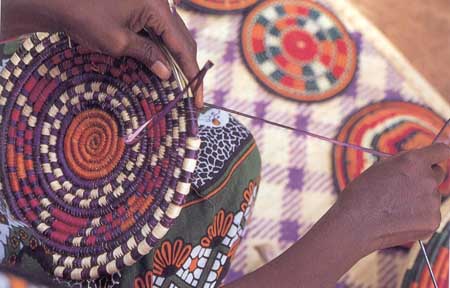

Basketry
Basketry is the oldest and highly developed craft in Uganda. This type of weaving is a foundation of
homemaking, building, and defense. Portable shields, stockades, enclosure fences, and houses are often
woven. Fences, granaries, reed work, thatching, traps, and heavy field baskets are made by men. Smaller
baskets for storing food in the house are made by women. The delicate fancy baskets, pot lids, and pot
stands are the product of endless hours of concentrated effort.
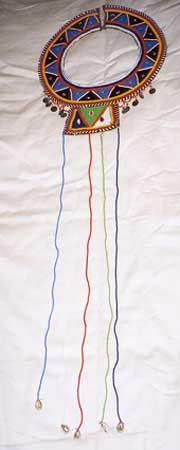
Masai Wedding Necklace
This wedding necklace would be worn by a Masai woman during her wedding. It's a large necklace, spanning
the shoulders of most women. It's very labor intensive to make. The thousands of beads that make up
its colorful patterns are inserted one by one into a wire frame which is then stitched onto a leather
background. For a couple of months, our necklace still smelled of campfire smoke!

Masai "Peace" or "Talking" Stick
The Masai people give this stick to other tribes as a peace offering. The chief's son also explained that it's a
talking stick -- an ancient communication tool. Only the holder of the stick speaks. Everyone listens,
everyone is respected.
![]()
Masai Bracelets
I bought these bracelets from four Masai women at their village. The Masai beads are tiny synthetic
colored beads available in a wide variety of colors and used in the production of colorful jewelry or
stitched on clothing, sandals, bags, etc. The Masai are traditionally the main users of these beads
as their women are expert jewelry makers. Working with the beads is extremely labor-intensive work
requiring nimble fingers and a patient heart. A typical bracelet can contain over 1,000 of these beads.
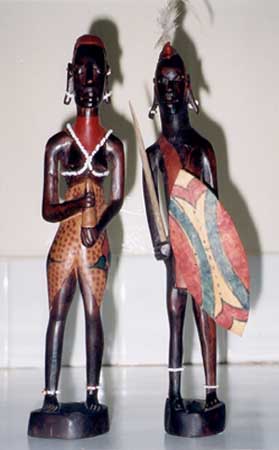
Masai Couple -- Warrior and Lady
This couple was made from Muhuhu wood (African Mahogany) and hand-carved by Kenyan artisans.
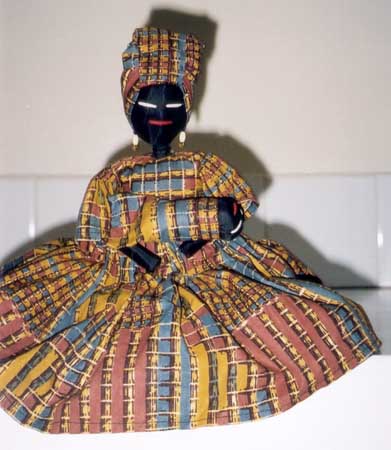
African Doll
Unlike most Western toys, African toys are almost always made of natural materials. Cloth, wood, and
reeds are the materials of choice.
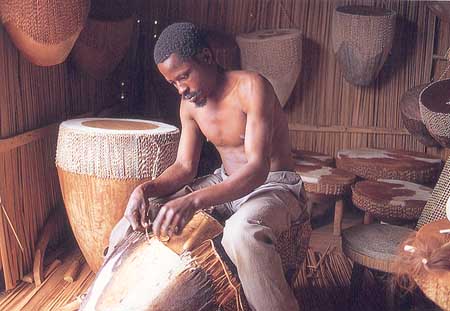

Drums
These traditional Ugandan drums were crafted using methods passed down through the generations. Drums have
been used in Africa traditionally for communicating and calling people to festive occasions. Today,
drums are used exclusively in traditional music and dance. These are handmade from cattle hide.
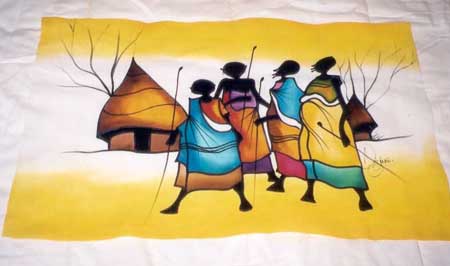
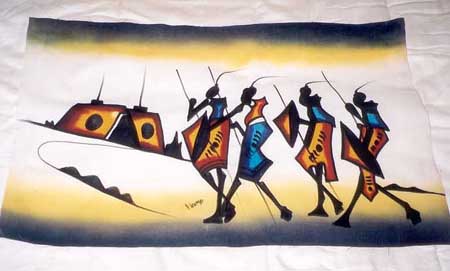
African Batik
African batik prints often depict the daily activities of people. Patterns also represent everyday tools,
carvings, beadwork, and give an idea of the artist’s own tribal history. Many batik patterns are printed on
Kente cloth or cotton and are increasingly being used by the fashion and upholstery industries.


Miscellaneous
Door stoppers.
Refrigerator magnets.
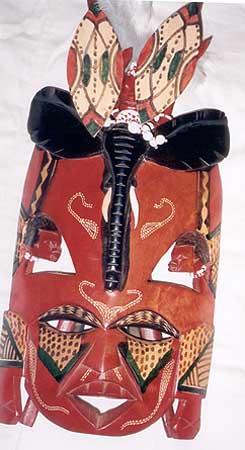
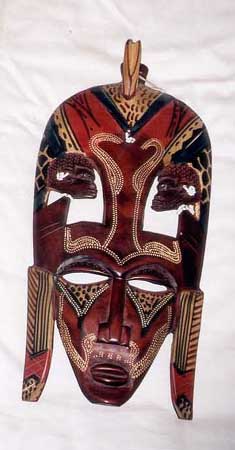
Masai Kissing Masks
These detailed Masai kissing masks are hand carved out of Muhuhu Wood (African Mahogany), richly painted,
and decorated by skilled Kamba craftsmen of Kenya.
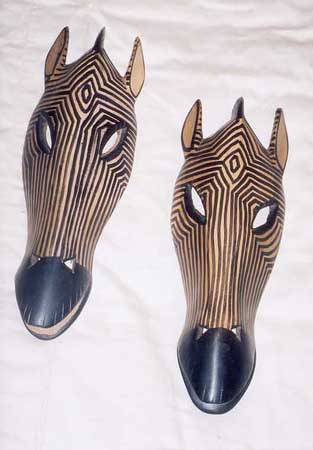
Zebra Face Mask
These African masks were hand carved from Muhuhu Wood (African Mahogany) by the tribesmen of Kenya.
History of African Masks
There is an African legend from the Congo about a little girl who followed her mother to a nearby spring
each day although she had been told not to. The mother warned her daughter and punished her. Still, the
little girl followed. Finally, in desperation, the mother painted a hideous face on the bottom of her
water gourd to frighten the child away. According to legend, this was the first mask ever made.
Masks have been used in ceremonies for almost all the important events of life, including birth, coming
of age, marriage, and death. They are used to stir fear in the enemy, to get rid of dangerous beasts
who prowl at night, or to ‘stop’ disasters, such as floods and earthquakes. They are used to disguise
actors to frighten away evil spirits, as no harm was suppose to come to the wearer
because no one knew who was behind the mask.
African tradition has long held the belief that the world was filled with spirits, both human and animal,
and that by carving masks of these spirits, they would become the spirits and have control over them.
When creating a wooden mask, the carver believes he is aided by his ancestors to choose just the right
piece of wood. Carvers believe that some kinds of wood can't be used because the evil spirits that
live inside the wood can hurt the carver and render the masks harmless. The ‘bad’ wood is sometimes
used, however, to make a fetish mask to combat evil spirits.
TOP OF PAGE
Copyright © 2002, Dawn M. Dalton.
All rights reserved
**LINKS**
WHERE?
WHY?
ITINERARY
PLAN YOUR TRIP
GETTING THERE
LONDON
KENYA
UGANDA
SAFETY
ITEMS BOUGHT
STAYING HEALTHY
COMMENTS
HOME
BHS HOME